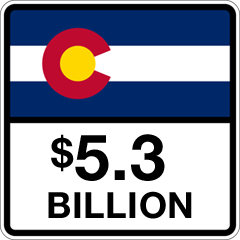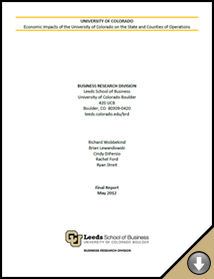CU impact worth $5.3 billion to Colorado economy
In the most comprehensive research yet conducted on what the University of Colorado means to the state’s economy, analysts show an economic impact of $5.3 billion for Colorado in 2011.
The research, conducted by the Business Research Division of the Leeds School of Business at the University of Colorado Boulder, provides the most comprehensive data yet compiled on the statewide economic impact from the university and the individual effects on Metropolitan Statistical Areas (MSA) with CU campuses.
“CU is a substantial, stable economic driver for Colorado that not only produces a highly educated workforce, but also creates jobs and companies in our state,” said CU President Bruce D. Benson. “Our faculty researchers also bring hundreds of millions to Colorado, which has significant ripple effects in key sectors of Colorado’s economy.”
The study was conducted by a team of researchers in the Leeds School of Business, led by chief analyst Richard Wobbekind. The team worked with campus business analysts, the Office of Technology Transfer in the University of Colorado system, and the offices of sponsored programs, as well as those from private-sector companies. They examined data compiled from fiscal years (FY) 2009-11, with a strong focus on numbers from FY2011.
“We looked at economic impacts on Colorado based upon examinations of operating expenditures, capital expenditures, employee salaries and benefits, and construction,” Wobbekind said. “What we found was a wide and deep economic reach: CU’s 57,400 students and 27,483 faculty, staff and student workers were engines of activity both as spenders and as generators of economic activity.
“The snapshot we generated illustrates just how economically productive CU is for the state of Colorado,” Wobbekind said, though he added that the study did not quantify the economic impacts of the nearly 200,000 CU alumni living and working in the state, nor did it quantify impacts derived from most visitors (visiting professors and researchers, alumni, sporting event spectators and others).
“Adding in those visitors would result in additional benefits to Colorado’s economy, primarily the hospitality sector,” Wobbekind said. “These impacts are subjects of future research.”
Other studies in recent years had calculated CU’s annual economic impact on the state to be as high as $6 billion; this latest CU analysis is intentionally conservative and is based on more accurate methodology.
Among the research group’s findings, which are available in a complete report at http://leeds.colorado.edu/brd#universityofcoloradoeconomicimpactstudy, are the following:
- The $2.6 billion in direct spending related to the University of Colorado led to $5.3 billion in economic activity in the state of Colorado in FY2011, resulting from the work of 17,860 faculty and staff.
- Faculty and staff participate in activities ranging from teaching and research to administrative and support, operating one of the largest institutions in the state of Colorado. The majority of economic activity stems from salaries and benefits, directly accounting for $1.2 billion in economic activity.
- Statewide, student spending was estimated at $500.9 million in FY2011 based on a system-administered survey, with CU-Boulder accounting for 63 percent of the total ($318 million), followed by the University of Colorado Denver and University of Colorado Anschutz Medical Campus (27 percent or $82.9 million) and the University of Colorado Colorado Springs (9 percent or $46.8 million). Nearly 38 percent of the spending was identified as housing expenditures, followed by groceries (11 percent) and books (11 percent).
- In FY2011, the University of Colorado secured more than $793 million in sponsored program awards from federal, state and private sources. Often thought of as “research grants,” sponsored program funding more broadly includes consulting agreements, scholarship awards and other funding. Sponsored program spending totaled $877.1 million for the year.
- Technology emerging from CU research laboratories enabled the founding of 11 new companies in FY2011. CU’s job creation typically concentrates on such high-tech industries as biotechnology and clean energy.
- CU’s spending of $246 million on construction projects in FY2011 resulted in an economic benefit of $478 million, bolstering an industry in need as the economy continues to recover. Funding for the projects, some of which are multi-year endeavors, largely came from private donations and bond financing, as state funding for construction has dwindled.
- The CU Anschutz Medical Campus and CU-Boulder accounted for 94 percent of federal funding expenditures and 93 percent of overall sponsored program expenditures. State awards expended for research totaled $32.3 million in FY2011, concentrated in activity at the CU Anschutz Medical Campus and CU Denver.
- In FY2011, the University of Colorado was the third-largest employer in the state of Colorado, and is among the largest employers in each county of operations. CU employed 27,483 faculty, staff and students in FY2011, with a total payroll of nearly $1.2 billion. Average earnings were $44,828, including student pay.
- Of the $1.1 billion in resident salaries, nearly $654 million was paid to employees living in the Denver MSA, $348 million to workers residing in the Boulder MSA, and $56 million to employees in the Colorado Springs MSA.



